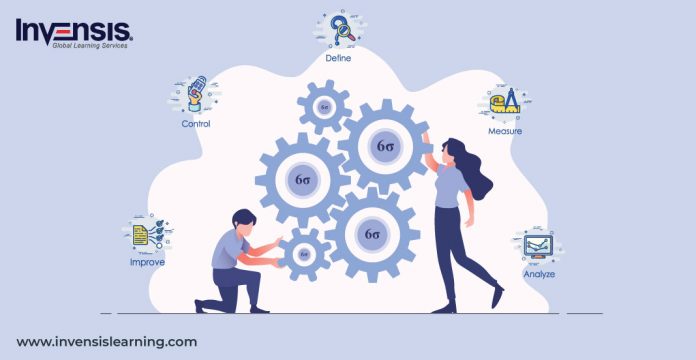
Six Sigma is a collection of strategies for designing, enhancing, and delivering high-quality business processes and outcomes. It draws its name from the statistical concept level 6 standard deviation (6 sigma departure) from the process norm, representing 3.4 failures per million opportunities. Standard procedure steps are performed to minimize and control variability and remove flaws. Typical design steps for a new process consist of DMADV (i.e., Define needs, Measure critical quality items, Analyze processes, Design product or service, and Verify need alignment). Common process steps for process improvement are DMAIC (i.e., Define opportunity, Measure performance, Analyze opportunity, Improve performance, and Control performance). So, read this blog for an in-depth understanding of Lean Six Sigma, its advantages, and how they are integrated.
The Advantages of Lean Six Sigma
Lean and Six Sigma, or Lean Six Sigma, provide a comprehensive set of processes and technologies that enable a company to improve quality and reduce costs, with the ultimate objective of continuous customer value generation. These are undeniably crucial advantages for any business. Nonetheless, Lean Six Sigma enterprises have the following five extra advantages:
Strategic Preparation
An organization’s mission and vision statements provide the impetus for strategic planning, with the mission statement focusing on the company’s raison d’être and the vision statement outlining its aspirations. The most effective strategic plans convert the vision statement into tangible and measurable goals, such as growing market share or decreasing employee turnover. In addition, Lean Six Sigma can expedite the accomplishment of these objectives.
Productivity
Firms eliminate volatility from their operations. Therefore, the productivity of their employee’s increases. It occurs for numerous causes. First, there is less rework when there is less waste and variety. When done the first time correctly, time is not spent correcting mistakes.
Employee Satisfaction
Greater employee productivity results in increased employee motivation and employee satisfaction. Employees who are not required to struggle through poorly designed procedures, create workarounds to complete tasks, or spend time on non-value-adding tasks are more motivated and happier. “It is not the only perk for employees. Employees become more attuned to recognizing waste and variation, as well as opportunities to enhance quality and provide additional customer value when enterprises integrate Lean Six Sigma into the fabric of their organizations.
Client Loyalty
Imagine a corporation adept at producing customer value, decreasing defects, lowering variation in its products and services, enhancing features and benefits, providing a wide range of options at minimal or no additional cost, and accelerating the delivery of its products. This business would undoubtedly enjoy high levels of customer satisfaction, which would translate to high levels of client loyalty and retention.
Supply Chain Management
To constantly improve processes, mature Lean Six Sigma organizations typically learn that they must eventually integrate suppliers into their quality improvement projects. Likewise, your suppliers must also eliminate waste and variation from their processes to eliminate waste and variation from your operations.
The Lean Methodology Roadmap
Lean and Six Sigma employ the same DMAIC approach, abbreviation for five phases.
- Define
- Measure
- Analyze
- Improve
- Control
The difference with Lean, however, is that this strategy is applied to a complete process as opposed to a specific chronic issue. As a result, the Lean DMAIC road map looks like this:
1. Define the Issue You Are Attempting to Solve
Consider it from more than a management standpoint. Listen to your employees’ perspectives on HR and performance management challenges and establish clear targets.
2. Evaluate Important Components of the Procedure
Target metrics will allow you to measure progress toward the specified objective and gather pertinent data.
3. Analyze the Data in Search of Cause-and-effect Relation
Here, you’ll put on your detective hat and search for the source of the defect you’re attempting to eliminate.
4. Enhance the Current Procedure
Six Sigma will suggest data analysis methodologies for leveraging the acquired information and reconfiguring the relevant process. Then, you can set up tests to see whether the improvement is genuine.
5. Maintain Process Management Moving Forward
Will take you through the procedures required to build up methods for monitoring the improved process after its implementation.
Some firms mix lean with Six Sigma to blend the introspective and interactive nature of the former with the data-driven insights of the latter.
How are Six Sigma and Lean Integrated?
Lean in Six Sigma focuses on a “team-centered managerial approach that attempts to increase performance by removing waste and defects” that blends the tools and concepts into a single, ultra-effective theory.
Together, they eliminate resources that do not provide value to the firm and are therefore considered waste. Simple-sounding, right?
The uncertainty of how the two ideas interact creates a dilemma regarding how to employ the systems effectively. However, with the proper amount of research and instruction, a business may seamlessly apply the two methods, decreasing waste by whichever method works best for it and creating a more efficient atmosphere.
Which One
The purpose of both of these techniques is to enhance the process. As a result, we are frequently asked the following queries:
“Should I implement Six Sigma or Lean?”
“Should we implement Lean or Six Sigma first?”
If you responded yes to these questions, as most people do, you likely require both Lean and Six Sigma technologies. In light of this, let’s examine two scenarios:
First, what is the result of not using Six Sigma with Lean?
Reducing inefficient steps in a process accelerates it because there is less labor to do. If process variation stays at unacceptable levels, resulting in defects, we now have a process that can produce defects more quickly.
What Is the Outcome of Six Sigma Implementation Without Lean?
Reducing variation throughout the entire process enhances output quality by decreasing faults. Unfortunately, since we have not eliminated non-value-adding phases, the process delivers a high-quality product or service at a high cost, affecting competitiveness and profitability.
Using Lean tools to eliminate non-value-added stages and Six Sigma to reduce variation in the remaining value-added phases is a sensible strategy. Criticizing variety in stages that will eventually be removed (see figure below) makes no sense. In the context of a development project, both approaches are utilized concurrently to achieve quality, speed, and cost enhancements.
Lean Vs. Six Sigma
In the manufacturing industry, there is considerable disagreement regarding the distinctions between Lean and Six Sigma and whether one is more effective. However, most individuals have very strong ideas regarding Lean versus Six Sigma, particularly regarding implementation and which technique is superior.
However, the meanings of the two terms have begun to converge, and there may be a valid explanation for that. Furthermore, both are comparable in many ways. The only variation is in the steps necessary to reach the final goal, but strangely, the end goal of minimizing waste is identical. Follow along as we describe the differences and parallels for further clarification.
What Are the Most Significant Distinctions Between Lean and Six Sigma?
Lean is not a replacement for Six Sigma and vice versa because they pursue higher effectiveness, efficiency, and cost reduction in distinct ways. In essence, they focus on distinct concerns.
For instance, Lean begins by examining workflow and defining value in terms of the customer benefits derived from the generated goods or services. Then, it is conducted through Rapid Improvement or Kaizen events instead of projects.
On the other hand, Six Sigma focuses on eliminating faults and waste to enhance quality and productivity. In addition to streamlining operations, this will result in increased customer satisfaction.
Six Sigma and Lean have become two of the most well-known and effective approaches for achieving revolutionary improvement. Both have evolved from the foundations of earlier approaches, such as Dr. Juran’s Universal Sequence for Breakthrough Quality Improvement, Drs. Shewhart and Deming’s PDCA Cycle and, as previously stated, Toyota’s unique emphasis on eliminating waste.
Lean and Six Sigma are distinct yet complementary improvement strategies. Six Sigma enables project teams to increase the effectiveness of processes, whereas Lean aids in enhancing process efficiency. Together, they can be integrated into the DMAIC model to produce a new effective and efficient process, reducing waste while generating value.
Six Sigma’s primary objective is to remove defects and waste while increasing quality and efficiency, enhancing business processes. Moreover, the notion is relevant to all organizational business functions, from the factory floor to accounting.
Similarly, Lean is utilized to streamline production and manufacturing processes. Lean focuses on eliminating unnecessary and wasteful manufacturing steps and ensuring that only essential steps remain.
Identifying the waste’s core cause is the same objective of both methods, but each uses a unique methodology. For example, in Six Sigma, waste results from process variance, but Lean, waste results from unnecessary procedures.
Lean Outlines Seven Wastes That Can Be Removed or Minimized to Boost Productivity.
- Overproduction
- Waiting
- Transport
- Motion
- Over-processing
- Inventory
- Defects
The objective of Lean is to eliminate the seven causes of waste. In contrast, to reduce waste, Six Sigma reduces errors in production and nonproduction areas. However, the two can operate together to boost factory-floor efficiency and production.
Conclusion
In conclusion, don’t restrict your alternatives in terms of continuous improvement initiatives. The methodologies and technologies of Lean Six Sigma have stood the test of time. Therefore, they ultimately deliver process performance outcomes. To paraphrase Dr. Deming once more: “We should work on our processes, not their outputs.” In other words, you will succeed if you concentrate on enhancing your procedures. However, focusing on outcomes will not necessarily result in efficient procedures. So, you can accomplish outcomes with ineffective procedures. The price we pay is high production costs, diminishing earnings, diminished competitiveness, and an inability to adapt quickly to client requests.
Moreover, Invensis provides extensive Lean Six Sigma certification programs for working individuals with varied levels of Lean Six Sigma experience. Therefore, the Lean Six Sigma certificate programs prepare professionals to meet the enormous demand for Lean knowledge, skills, and certification.
Invensis provides the following courses:

















